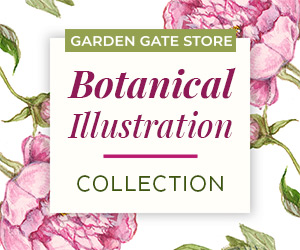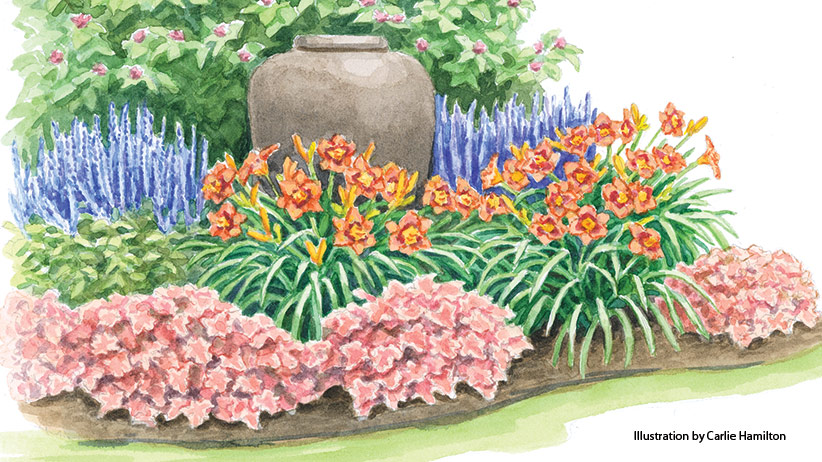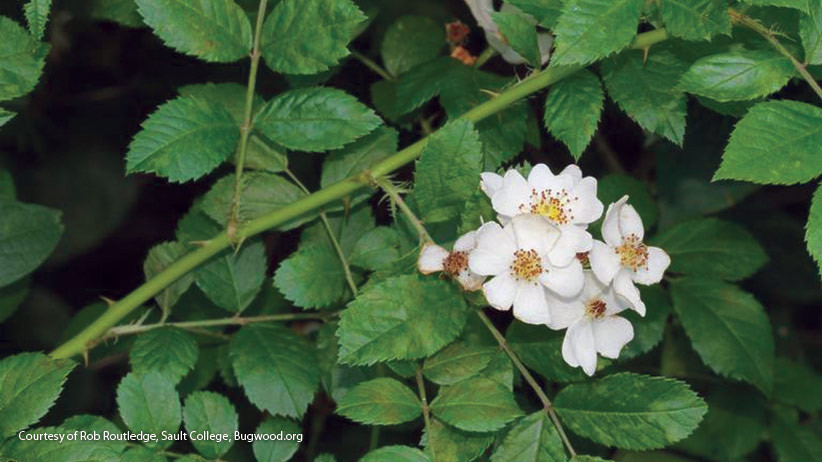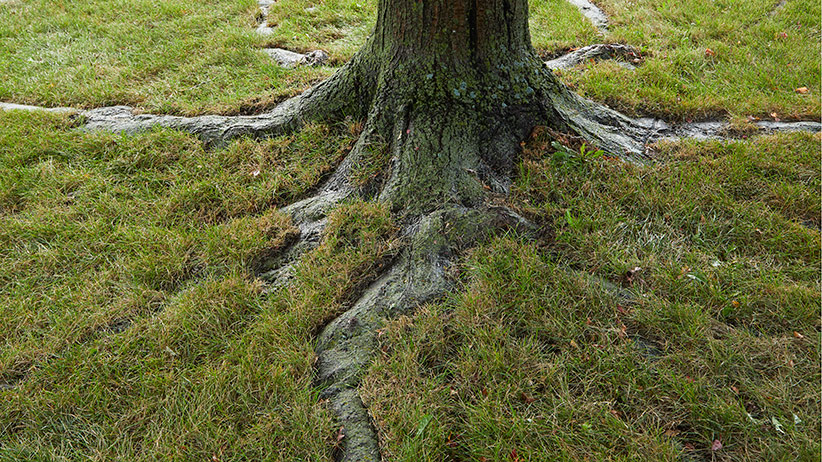
Is “No-Mow May” a good idea?
The goal of the No-Mow May movement is to let your lawn and flowering plants grow in spring to provide early-season forage for pollinators. But when May is over and it’s time to mow again, it can be a bit of a shock to your turfgrass, and those habitats you’ve created vanish overnight.
Whether or not you plant a bee lawn, making a few changes to your lawn maintenance program can still help pollinators throughout the year instead of just in May. James Wolfin, conservation specialist for Twin City Seed, advocates for “slow-mow summer.” Let your turfgrass grow up to 6 inches tall before you cut a third of it off. Why is this a good idea? It allows flowering plants mixed into your lawn to bloom and feed pollinators. If the flowering plants in your lawn are invasive reseeders, such as dandelions (Taraxacum officinale), you may just want to make sure that you mow as many as you can before they go to seed.
The buzz about bee lawns
It’s no secret that bees, butterflies and other pollinating insects need our help. Garden enthusiasts have been rolling up their sleeves planting pollinator gardens and weaving native plants into their landscapes to throw these crucial critters a lifeline. But have you ever thought about taking it up a notch and swapping your regular turfgrass lawn for a bee-friendly version? It’s like giving bees and pollinators their very own welcome mat!
As a Minnesota conservation specialist, James is all too happy to enlighten others about the many benefits of bee lawns. And his knowledge isn’t just theoretical: He and the team at Twin City Seeds in Minneapolis have helped homeowners across the United States plan, install and maintain hundreds of them in the last several years. Keep reading to see if one might be right for you.
What’s a bee lawn?
James says, “A bee lawn still functions as a traditional lawn space, but is designed to be more beneficial to pollinators.” While conventional yards are made up of only turfgrass, a bee lawn adds pollinator-friendly flowers to the mix. And these plants bloom at different times but overlap, so there’s always something flowering in the yard to keep pollinators fed.
A successful bee lawn seed mix is about 92% turfgrass and 8% flowering plants.
You might be thinking, “Do I already have a bee lawn if I let my lawn weeds, such as dandelion and creeping charlie (Glechoma hederacea), bloom?” Probably not. While pollinators do visit these flowers, they aren’t the best long-term choices because of their invasiveness. On the other hand, the non-native white clover, which is often thought of as a lawn weed, isn’t aggressive enough to be considered invasive, and pollinators love it. The best mix of plants in a bee lawn includes slow-growing turfgrasses and low-growing flowering plants. See a few of James’ recommendations at the bottom of the article.
Related Articles:
Native Bees Overwinter in Unexpected Places
Pollinator Garden Planting Ideas
Use Flower Shapes to Attract Diverse Pollinators

Is a bee lawn right for you?
The goal of a bee lawn is to keep pollinators fed and flourishing from early spring until frost, especially when their usual buffet is in short supply. But there’s a bonus for you too: Bee lawns require less mowing, water and fertilizer, which means more time for you to enjoy the outdoors!
Want to help the bees but still have room for the kids and pets to run? No problem. While you might choose to replace your existing turfgrass with a bee lawn, transforming your entire yard isn’t a must. Consider turning a little-used spot into a bee-friendly one. It’s a good way to give the concept a try, and it sidesteps concerns about bees buzzing too close to where your kids or pets play. You could keep the backyard for those family BBQs and designate the front or side yard for your bee lawn. Want to know how to turn your traditional turf into a more hard-working bee lawn? Keep reading to meet the best plants and find out how to start the transformation.
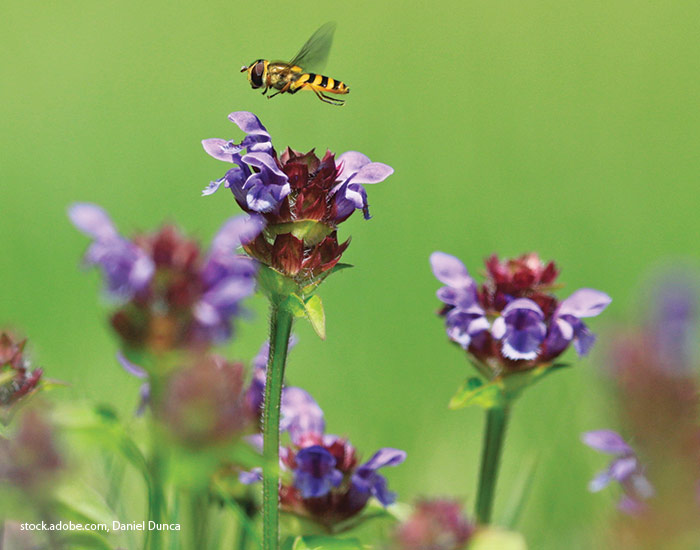
How to Grow a Bee Lawn
Ready to start a bee lawn? After you’ve chosen a location, you can start choosing the plants. Start with the lists below to learn which flowers and grasses will work best for you.
Installing a bee lawn could be as easy as sowing the flower seeds into your existing turfgrass, but in some cases, you’ll have to remove everything and replant. Find out which approach will work best for you in “Do You Need to Start Over?” below.
Getting a bee lawn started
James prefers seeding in the fall right before the first frost in Minnesota gardens because the seeds remain dormant through the winter but are kept moist as they’re germinating by melting snow and spring rains. In areas where you don’t get reliable snow cover, James says you can start your seeds in spring or late fall. As with all plants, seedlings might require extra attention in the first year: Water new plants enough that their still-developing root systems don’t dry out, and pull weeds that might threaten to overcrowd the growing plants. By year three your bee lawn will be in full swing.
How to maintain a bee lawn
Once it’s established, taking care of a bee lawn isn’t all that different from your regular turfgrass: When the lawn is about 5 to 6 inches tall, it’s time for its first trim. Rather than mowing on a set schedule, pay attention to the length of the grass, never cutting more than a third. For example, if you let grass grow to 6 inches, cut it to 4 inches. And when those bee-loving blooms are in full swing, let your mower rest a bit longer to give pollinators a chance to feast. Established bee lawns don’t require much fertilizer, if any. One light application of lawn fertilizer in the spring or fall is enough to keep your bee lawn healthy. And lawn clippings left on the soil to decompose act as natural fertilizer.
Related Articles:
Video: How to Plant a Bulb Lawn for Pollinators
Spring Plants for Pollinators
The Pollinator Collection
How to install a bee lawn
Do You Need to Start Over?
You'll need to remove your lawn and plant new turfgrass and flowers if the following apply:
- Your existing lawn is filled with aggressive turfgrasses, such as perennial ryegrass (Lolium perenne) tall fescue (Festuca arundinacea).
- Your lawn contains a lot of invasive weeds, such as such as creeping charlie, dandelions, crabgrass or crown vetch (Securigera varia).
- To prepare for a new bee lawn, remove existing turfgrass, lightly till the area, and use a rake to smooth it out so you’re ready to put seeds down. When planting seeds on bare soil, rake them in slightly.
You can overseed your lawn with flowers if the following apply:
- Your turfgrass is primarily slow-growing grasses, such as Kentucky bluegrass or fine fescues.
- Weeds are few and far between, making it easy to clear them out.
- To prepare for overseeding, mow the lawn to about 1 inch and rake away the clippings to clear the way for new seeds. Aerate the lawn if you can, especially if you have compacted soil. This will improve soil oxygen, water and nutrient flow and germination rates.
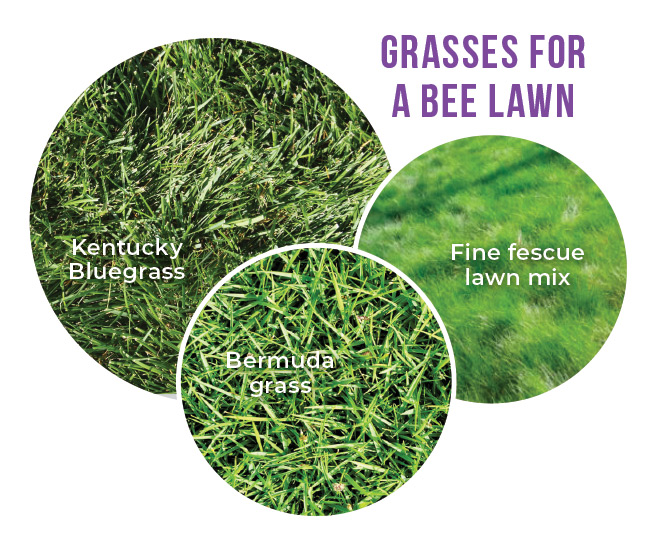
Grasses for a bee lawn
The best grasses to incorporate into your bee lawn are those that require little water or fertilizer and grow slowly so they won’t out compete their companions.
- Hard fescue Festuca longifolia
-
Cool-season grass; low water and fertilizer needs; 9 to 24 in. tall and wide; cold hardy in USDA zones 3 to 9
Note that all other fine fescues, such as creeping red (F. rubra), slender creeping (F. rubra litoralis), chewings (F. rubra commutata), and sheep (F. ovina) or a mix are all good options. -
Kentucky bluegrass Poa pratensis
Cool-season grass; tends to need more water and fertilizer compared to fine fescues; 3 in. tall, 6 in. wide; cold hardy in USDA zones 3 to 7 -
Bermudagrass Cynodon dactylon
Warm-season grass; drought tolerant; grows densely; tolerant of foot traffic; 3 to 6 in. tall and wide; cold hardy in USDA zones 7 to 10 -
Buffalo grass Buchloe dactyloides
Warm-season grass; native; drought-resistant; 3 to 9 in. tall, 6 to 12 in. wide; cold hardy in USDA zones 4 to 8 -
Blue grama grass Bouteloua gracilis
Warm-season grass; drought-tolerant; grows in any soil type; disease- and pest-resistant; 9 to 24 in. tall, 18 to 24 in. wide; cold hardy in USDA zones 3 to 10
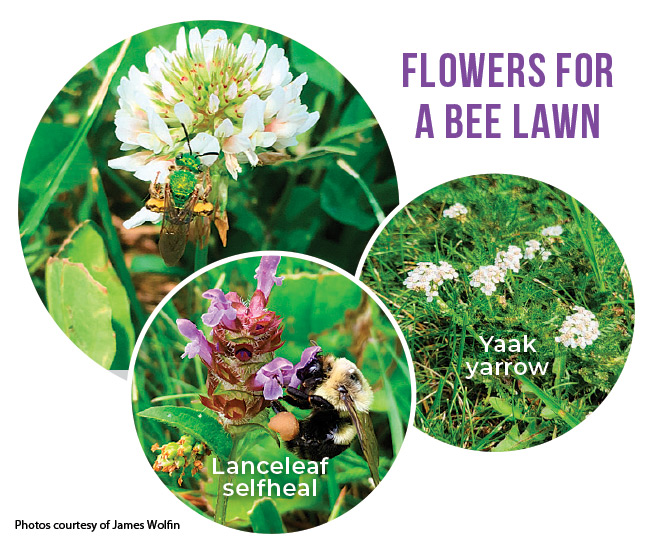
Flowers for a bee lawn
Low-growing flowers that can tolerate the stress of mowing and foot traffic and continue to bloom work best in a bee lawn.
-
White clover Trifolium repens
White flowers bloom from spring to fall; nitrogen-fixing legume; high pollen and nectar content; honeybee favorite; adaptable to different soil types; 3 to 6 in. tall, 12 to 18 in. wide; cold hardy in USDA zones 3 to 10 -
Creeping thyme Thymus serpyllum
Pink flowers bloom from midsummer to fall; mostly nectar but some pollen; 3 in. tall, 3 to 12 in. wide; cold hardy in zones 4 to 9 -
Lanceleaf selfheal Prunella vulgaris subsp. lanceolata
Tubeshaped purple flowers bloom from midsummer to early fall; native; high nectar content; grows in a wide range of soil types; 6 to 12 in. tall, 12 to 24 in. wide; cold hardy in USDA zones 4 to 9 -
Yaak yarrow Achillea millefolium var. occidentalis
White flowers bloom from summer to fall; native; high pollen and nectar content; drought-tolerant; doesn’t require much water or fertilizer; tolerant of sandy soils; up to 24 inches tall; cold hardy in USDA zones 3 to 9 -
Tufted poppy Eschscholzia caespitosa
Bright orange flowers bloom in midsummer; drought-tolerant; high in pollen and nectar; grows in a variety of soils; 12 to 18 in. tall and wide; cold hardy in USDA zones 8 to 9 -
Wild petunia Ruellia humilis
Lavender-purple flowers bloom from spring to fall; high nectar content; drought-tolerant; disease and pest resistant; 18 to 24 in. tall and wide; cold hardy in USDA zones 4 to 9
Bee lawn seed source
Twin City Seed, twincityseed.com,
952-944-7105







